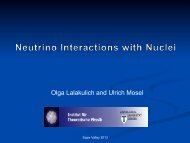HELIOS and the radioactive beam program at Argonne
HELIOS and the radioactive beam program at Argonne
HELIOS and the radioactive beam program at Argonne
Create successful ePaper yourself
Turn your PDF publications into a flip-book with our unique Google optimized e-Paper software.
4 B.B.Back et al.<br />
performed in inverse kinem<strong>at</strong>ics will play a central role in advancing our underst<strong>and</strong>ing<br />
of nuclei far from stability; first with rel<strong>at</strong>ively weak <strong>beam</strong>s from HRIBF<br />
<strong>at</strong> ORNL, ISAC-2 <strong>at</strong> TRIUMF, Rex-Isolde <strong>at</strong> CERN, ReA-3 <strong>at</strong> NSCL, Spiral-2 <strong>at</strong><br />
GANIL <strong>and</strong> CARIBU <strong>at</strong> ATLAS, but on a longer time scale abundant <strong>beam</strong>s from<br />
FRIB will substantially exp<strong>and</strong> <strong>the</strong> range of nuclear transfer reaction studies.<br />
The inverse kinem<strong>at</strong>ics method carries with it, however, substantial obstacles for<br />
obtaining sufficient energy resolution to be able to separ<strong>at</strong>e adjacent nuclear st<strong>at</strong>es<br />
when <strong>the</strong> ejectiles are measured as a function of emission angle. In many cases, <strong>the</strong><br />
forward angles in <strong>the</strong> center-of-mass system correspond to very backward sc<strong>at</strong>tering<br />
angles in <strong>the</strong> labor<strong>at</strong>ory, where kinem<strong>at</strong>ical compression of <strong>the</strong> nuclear st<strong>at</strong>es into<br />
a small energy interval can be quite severe as illustr<strong>at</strong>ed in Fig. 2. This effect<br />
limits <strong>the</strong> achievable Q-value resolution <strong>and</strong> <strong>the</strong> ability to identify particles using<br />
<strong>the</strong> st<strong>and</strong>ard ∆E-E technique. At first glance, <strong>the</strong>se experimental limit<strong>at</strong>ions would<br />
appear to severely limit <strong>the</strong> utility of transfer reaction studies using <strong>radioactive</strong><br />
<strong>beam</strong>s. As explained in <strong>the</strong> following section, <strong>the</strong>se problems can be overcome by<br />
employing a new concept in which <strong>the</strong> ejectiles are transported back to <strong>the</strong> <strong>beam</strong><br />
axis in a homogeneous magnetic field aligned with <strong>the</strong> <strong>beam</strong> axis, a method th<strong>at</strong> is<br />
realized in <strong>the</strong> recently commissioned <strong>HELIOS</strong> spectrometer <strong>at</strong> ATLAS.<br />
Fig. 3. Schem<strong>at</strong>ic illustr<strong>at</strong>ion of <strong>the</strong> <strong>HELIOS</strong> concept. From <strong>the</strong> left, <strong>the</strong> <strong>beam</strong><br />
enters <strong>the</strong> homogeneous, axial field region through <strong>the</strong> hollow Si detector array.<br />
Backward-going charged particles follow helical trajectories <strong>and</strong> are intercepted by<br />
<strong>the</strong> position-sensitive Si detector before returning to <strong>the</strong> <strong>beam</strong> axis. Coincidences<br />
with recoils detected in a forward detector may be used, if needed.<br />
4. The <strong>HELIOS</strong> concept<br />
The basic principle of this spectrometer [6] is th<strong>at</strong> in a sufficiently strong, homogeneous,<br />
longitudinal magnetic field B, charged particles with mass m <strong>and</strong> charge<br />
q, emerging from <strong>the</strong> <strong>beam</strong>-target interaction point, will follow helical trajectories





